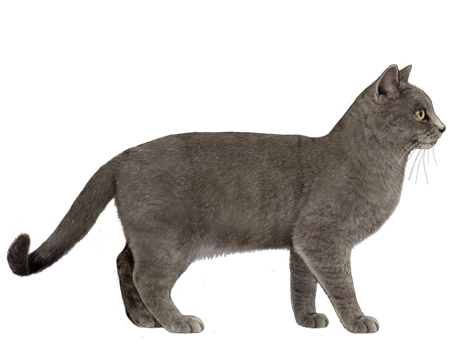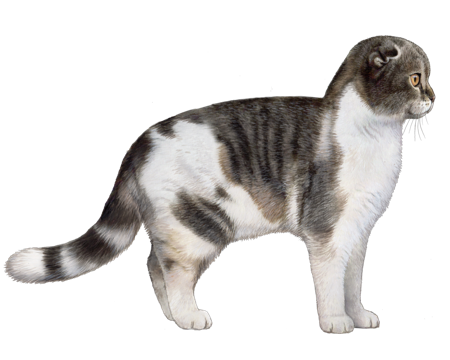
Chartreux
Chartreux are known for their captivating eyes and permanent smiles. But it's their human who can't stop smiling when spending time with these friendly, easygoing felines.
Interested in discovering if your cat is a Chartreux?
Check out Wisdom Panel's DNA test.
Chartreux Traits
General Appearance
Chartreux are medium-size cats with sturdy builds and dense, water-repellent fur. They're husky with broad shoulders, deep chests, and fine-boned legs.
Coat and Coloring
The Chartreux's medium-short, wooly coat consists of a resilient topcoat and a soft, warm undercoat. It has silver tips and comes in shades of blue-gray that range from ash to slate.
Distinctive Physical Traits
Key features of the Chartreux include a rounded head, full cheeks, a sweet, smiling expression, and round eyes that range from copper to gold.
Chartreux Temperament
Chartreux are quiet, low-key cats. Though reputed to be reserved, they're affectionate and devoted to their humans. This breed values companionship but doesn't expect constant attention. Chartreux enjoy following their family members around the house—but at a slight distance. Their friendliness with dogs and other pets, as well as kids, makes them an excellent addition to most families.
These intelligent cats can quickly learn to perform tricks or play games of fetch. They're skilled climbers, impressive acrobats, and masters of puzzle toys. Chartreux tend to form routines. Yet, they're rather adaptable when introduced to new surroundings—making them excellent furry travel companions.
Chartreux History
No one knows precisely when or where the Chartreux originated, though several theories exist. Some people believe they lived alongside France's Carthusia monks and protected the ingredients for the monk's Chartreuse liqueur. Others think the Chartreux originated in Syria, and crusaders brought them to France in the 13th century. Regardless, we know for certain that Chartreux cats appeared in French literature as early as the 16th century. And today, they're considered the national cat of France.
Formal breeding of the Chartreux began in the 1920s, but the program suffered during World War II. With the breeding stock greatly diminished after the war, breeders introduced blue British Shorthairs and Persians to preserve both a sound genetic base and the cats' overall appearance.
The North American breeding program began in 1970 when John and Helen Gamon imported the first Chartreux. They became advocates for the breed, but it remains rare in the U.S. and Canada. The CFA granted Championship status to the Chartreux in 1987.
Chartreux Care
Nutrition
Chartreux require a high-quality diet. Because nutritional needs vary for kittens, adults, and senior cats, opt for a formula that's age-appropriate for your pet.
All cats are at risk of obesity—especially as they age and their activity levels decline. To help your Chartreux maintain a healthy weight, measure out meals and reduce portions if necessary. And be sure to account for treats. As a guideline, they should make up no more than 10% of a cat's calories.
Lastly, all cats need access to fresh, clean water around the clock.
Grooming
The Chartreux's thick coat requires weekly brushing to remove loose fur and prevent mats. You can expect to brush more frequently twice a year—when they shed their undercoats.
Most cats' nails require monthly trimming to prevent them from getting too long. Long nails are more likely to snag on something and become torn or damaged. They can even grow into your cat's paw pads, leading to pain or infection. In addition to clipping, providing a scratching post will allow your cat to do some nail maintenance themselves (thanks to their instinct to scratch).
Good dental hygiene is essential to a Chartreux's overall health. An ideal dental routine includes daily at-home teeth brushing combined with visits to the veterinarian for professional dental cleanings and exams.
Health
Roughly one out of every three cats in the United States is overweight or obese. And those extra pounds can contribute to other health risks—such as arthritis, diabetes, and heart problems. Your veterinarian is the best resource for tips on managing your cat's weight.
Chartreux Genetic Health Conditions
-
Mucopolysaccharidosis Type VI
Mucopolysaccharidosis Type VI is a rare disorder causing dwarfism, degenerative joint disease, and clouding of the eyes.
With more than 45 health tests, Wisdom Panel™ Complete for Cats screens for these and other important genetic conditions—allowing you to better plan for your cat's lifelong care.
Breed Group
Persian
An ever-popular variety, the breeds within this group tend to share a common genetic connection with Persian cats.
Resources
https://tica.org/breeds/browse-all-breeds?view=article&id=833:chartreux-breed&catid=79
https://vcahospitals.com/know-your-pet/cat-breeds/chartreux
https://cfa.org/wp-content/uploads/2019/06/chartreux-standard.pdf
https://www.royalcanin.com/us/cats/breeds/breed-library/chartreux
https://www.banfield.com/state-of-pet-health/obesity
Reviewed February 23, 2021 by Annette Louviere, DVM

















